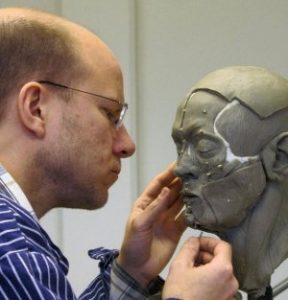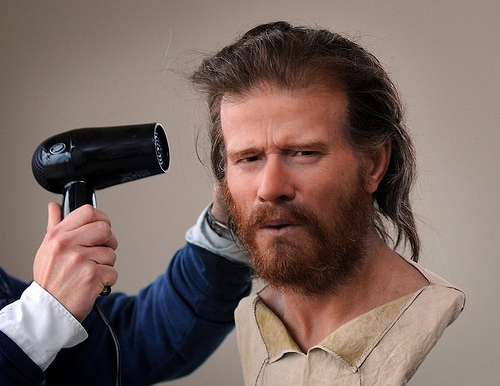
Within his studio in the Stockholm suburban community of Tumba, Sweden, archaeologist-sculptor Oscar Nilsson is applying a highly specialized knowledge and set of skills to reconstruct realistic and scientifically-informed likenesses of individuals who lived long before us.
His work, unlike more ‘sensational’ archaeological and paleoanthropological discoveries reported in the press such as the identification of the bones of King Richard III and the more recent discovery of Homo naledi, do not make headlines. But he makes both written and unwritten history an up-close-and-personal experience for academics and the public alike. He creates, quite literally, faces of our collective past.
One of his upcoming projects involves the reconstruction of the face of a Stone Age man whose remains were unearthed near Ulricehamn, Sweden in 1994.
“Judging from his bones he was extremely robust with very broad shoulders,” said Nilsson.“And the skull of this 45-60-year-old man exhibits a significant elevated ridge running from his forehead to the back of his head, making it peak-shaped from a frontal view. These well-preserved bones surprised everyone when the result of the C14 dating came back: he was 10,000 years old and, with that, Sweden’s oldest skeleton.” Archaeologists have named him “Bredgården Man”. His skeletal remains were found near a farmhouse by the same name.
Another upcoming project involves the facial reconstruction of a 14-year-old Stone Age girl whose remains were excavated together with a small child at Tybrind Vig in Denmark in the 1970’s. Here, archaeologists excavated unusually well-preserved artifacts from the Ertebølle Culture, a European Neolithic culture, including a large kitchen midden. “To recover the girl’s remains and those of the child, archaeologists had to work underwater, as the bones were submerged 300 meters offshore to a depth of 3 – 4.5 meters,” said Nilsson. “In her time, her place of rest would have been dry, hugging the shore, when there was a greater abundance of inland ice in Scandinavia and the sea level was lower.”
The Stone Age girl reconstruction will join other objects of the Tybrind Vig discoveries at Denmark’s Moesgård Museum.
In fact, most of Nilsson’s hyper-realistic reconstructions end up in museums such as the Moesgård, where he hopes the public will, through his reconstructions, gain a more personal connection to history.
“History is made of actual people,” he says. “Making a facial reconstruction is like opening a window to the past, an opportunity to see what the people from history really looked like. So the face tells a direct story to the beholder, establishing an emotional and personal connection that text or written records can never accomplish.”
One of Nilsson’s Stone Age period subjects already graces an exhibit space at the Stonehenge Visitor Center near Salisbury, England. It is the reconstructed face of an early Neolithic man excavated in 1863 from a long barrow at Winterbourne Stoke, Wiltshire. Radiocarbon dated to between 3630 and 3660 BCE, analysis of his remains showed the man to be 25-40 years old with a slender build. He lived about 500 years before the circular ditch and banks, the first monuments at Stonehenge, were even built. Further analysis of his remains and the circumstances of his later Neolithic reburial indicated that he was a person of importance or high status. His connection to the Stonehenge culture is unknown, but it is clear that he was an elite member of a people who lived hundreds of years before the great monumental stones of Stonehenge were raised.
Nilsson creates his pieces using 3-D models of the original skulls of his subjects, developing models by applying non-drying plasticine clay to recreate the muscles and tissues using traditional sculpting tools and then applying the finishing work on Acrystal molds of his resulting models. To do this accurately, Nilsson obtains information about the times and places in which the persons lived, the contexts and circumstances of the original skeletal finds, and detailed findings from the examining osteologists and forensic experts about the skulls of the individuals excavated or exhumed. The results, in addition to being astonishingly realistic, provide three dimensional likenesses of the individuals, something that cannot be realized even by typical artist depictions through two dimensional paintings.
________________________________________________________________
Above: Nilsson puts the finishing touches on the reconstructed face of the ‘Stonehenge Man’. Explains Nilsson about the subject: “The grave was discovered in the late 19th century but the bones were recently the subject of extensive analysis and surveys. Some of the results from those analyses are amazing: He was born around 5,500 years ago well to the west or north west of the Stonehenge area, probably in what is today Wales, Devon or Brittany. At 2 years old he moved to the area near Stonehenge, and aged 9 he moved back to the west again. As he grew older his frequency of travel back and forth between those two places increased. How do we know all this? By analyzing the successive layers of the enamel in his teeth, isotopic values of strontium and oxygen reflected the sources of his drinking water.
He lived some time before the famous stone circle was built, but decades after his death, the mound of his grave was massively enlarged, one of the grandest known from Neolithic Britain. We also know from the analysis that he had a much higher percentage of meat and dairy products in his diet than would probably have been normal at the time. And he was taller than the average Neolithic man—172 cm compared to the average height, 165 cm. So, this was clearly a person of high status in his society.” Photo by Clare Kendall/English Heritage
________________________________________________________________
For more detailed information about Nilsson’s work, how he does it, and the other subjects he has reconstructed, see the feature article in the Fall issue of Popular Archaeology Magazine.
________________________________________________________________
Image first from top, right: Nilsson working on a subject in his studio. Courtesy Oscar Nilsson
________________________________________________________________
In addition, the latest Popular Archaeology ebook is now available.
______________________________________________
Travel and learn with Far Horizons.
____________________________________________
 This richly illustrated ebook version of a recent Popular Archaeology issue includes the following stories: The discovery of the tomb of a previously unknown pharaoh that is shedding light on a lost ancient Egyptian dynasty; how genetics is revolutionizing what we know about human evolution and our prehistoric past; one scholar’s controversial ‘New Chronology’ and how it supports the historicity of the biblical Exodus; how archaeologists are unearthing new history in Williamsburg, Virginia, a seat of British colonial power in 18th century America; the discovery of the remains of a major Roman legionary base in Israel; the unearthing of an ancient Judean fortified settlement in the borderlands between the biblical kingdoms of ancient Judah and the Philistines; and how archaeologists are uncovering evidence of what may have been an important administrative center of Judah during the 8th century BCE. Now available from Amazon.com!
This richly illustrated ebook version of a recent Popular Archaeology issue includes the following stories: The discovery of the tomb of a previously unknown pharaoh that is shedding light on a lost ancient Egyptian dynasty; how genetics is revolutionizing what we know about human evolution and our prehistoric past; one scholar’s controversial ‘New Chronology’ and how it supports the historicity of the biblical Exodus; how archaeologists are unearthing new history in Williamsburg, Virginia, a seat of British colonial power in 18th century America; the discovery of the remains of a major Roman legionary base in Israel; the unearthing of an ancient Judean fortified settlement in the borderlands between the biblical kingdoms of ancient Judah and the Philistines; and how archaeologists are uncovering evidence of what may have been an important administrative center of Judah during the 8th century BCE. Now available from Amazon.com!
____________________________________________









